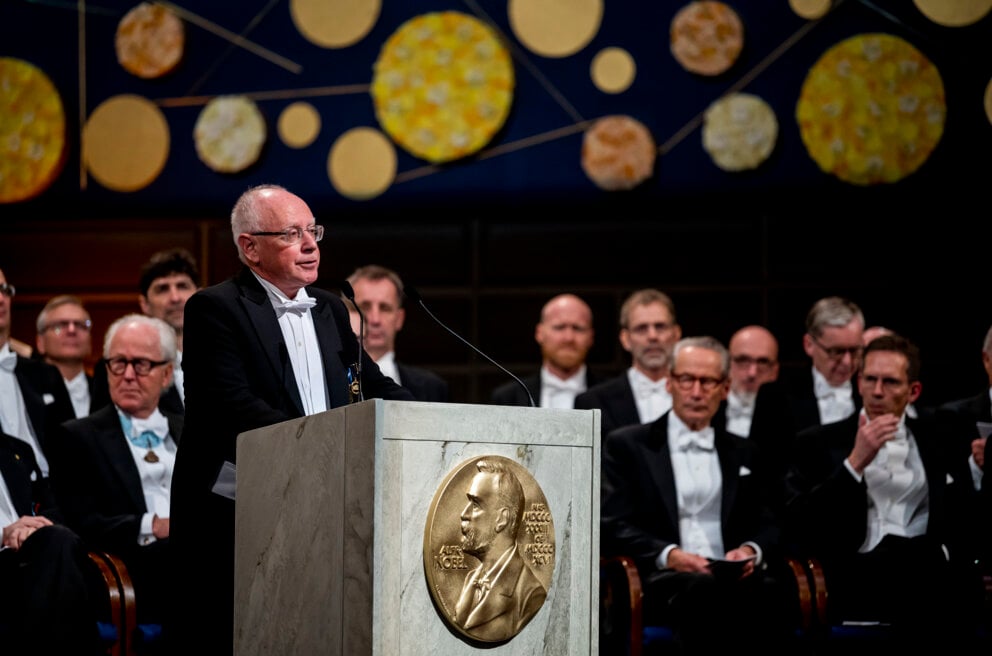Award ceremony speech

Professor Mats Larsson delivering the presentation speech for the 2019 Nobel Prize in Physics at Konserthuset Stockholm on 10 December 2019.
© Nobel Media. Photo: Alexander Mahmoud.
English
Swedish
Presentation Speech by Professor Mats Larsson, Member of the Royal Swedish Academy of Sciences; Chairman of the Nobel Committee for Physics, 10 December 2019
Your Majesties, Your Royal Highnesses, Esteemed Nobel Laureates, Ladies and Gentlemen,
This year’s Laureates in Physics have taken us along on a journey that began when the Universe was very young − less than 400,000 years − and which continues to this day.
The young Universe can be described entirely according to the laws of physics. The formation of the first atoms marked the first step towards the Universe we know today. The temperature was about 3,000 degrees Celsius, and the radiation that so far had been confined in a primordial soup of electrons and protons now began to break free, as atoms were formed by a fusion of protons and electrons. Since it was discovered by humans in the mid-1960s, this cosmic radiation has provided the oldest and purest information we have about the early Universe. By that time, James Peebles already realised that cosmic background radiation plays a crucial role in how stars and galaxies are formed. His theoretical discoveries in physical cosmology have subsequently laid a foundation for interpreting the measurements of background radiation that are being carried out in satellite-based missions, using more and more refined technology. Fluctuations in the background radiation that was frozen out during the transition between the impenetrable primordial soup and a transparent early Universe consisting of hydrogen and helium could be given a theoretical interpretation and meaning. Peebles’ introduction of cold dark matter and his re-introduction of Albert Einstein’s cosmological constant − also known as dark energy − were the final pieces of the puzzle in the cosmological standard model, which describes the Universe at an extraordinarily detailed level. We know that the Universe is entirely dominated by dark matter and dark energy, but its physical origins remain shrouded in mystery.
The sun, the moon and the brightly shining planets in our own solar system, as well as the stars that are visible with the naked eye, have been known to human- ity since prehistoric times. But are there planets that orbit stars similar to our own sun? Is our solar system unique, or are there other planetary systems? Until quite recently, in a historical perspective, these questions remained unanswered. The reason is simple; planets orbiting other stars cannot be directly observed, since the light they emit is too faint. Instead we must look for the slightly rocking motion a star makes if a planet, for example one the size of Jupiter, is rotating around it. Michel Mayor and Didier Queloz built an instrument − a spectrograph − that can measure such movement by utilising the Doppler effect. Many people are aware of how the Doppler effect influences sound. We hear a higher-pitched sound from an emergency vehicle that is approaching us, but a lower-pitched sound as it moves away from us.
In October 1995, Mayor and Queloz announced the dis- covery of a Jupiter-like planet orbiting the star 51 Pegasi in the constellation known as Pegasus, about 50 light years away from Earth. It moves around its star at very high speed; a Pegasi year takes just over four days, compared to Earth’s one year and Jupiter’s 12 years. Other astronomers were quickly able to confirm this discovery, and since then the new field of “exoplanets” has literally exploded. Today more than 4,000 exo- planets within a few thousand light years of earth have been observed, enabling researchers to draw the conclusion that in our own Milky Way galaxy alone, there are perhaps 100 billion planetary systems. Technological development is progressing rapidly, and the question of whether there is life elsewhere in the Universe than in our own solar system will engage a new generation of astronomers.
Professors Peebles, Mayor and Queloz, you have been awarded the 2019 Nobel Prize in Physics for your out- standing contributions to our understanding of the development of the Universe from its early childhood to the present day, and our Earth’s place in the cosmos. On behalf of the Royal Swedish Academy of Sciences, it is my honour and great pleasure to convey to you our warmest congratulations. I now ask you to step forward to receive your Nobel Prizes from the hands of His Majesty the King.
Nobel Prizes and laureates
Six prizes were awarded for achievements that have conferred the greatest benefit to humankind. The 12 laureates' work and discoveries range from proteins' structures and machine learning to fighting for a world free of nuclear weapons.
See them all presented here.
